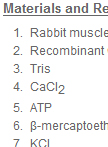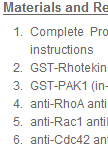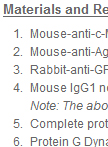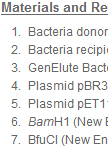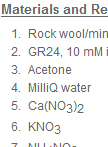Improve Research Reproducibility A Bio-protocol resource
- Protocols
- Articles and Issues
- About
- Become a Reviewer
Past Issue in 2012
Volume: 2, Issue: 19
Biochemistry
Co-sedimentation Assay for the Detection of Direct Binding to F-actin
This protocol describes measurement of direct protein-protein interactions by actin co-sedimentation assay. The actin co-sedimentation assay is a well-established technique and has been commonly used to demonstrate binding of proteins that interact directly with actin filaments (Ahrens et al., 2012; Mehta and Sibley, 2010; Schuler et al., 2005; Singh et al., 2011). We and others have previously shown that the damaged cell-recognition molecule C-type lectin 9A (Clec9A) recognises a conserved component within nucleated and non-nucleated cells that is exposed only when the cell membrane is damaged (Srivastava and Barber, 2008; Zhang et al., 2012). Here we use Clec9A as an example and present a detailed procedure for demonstrating the direct binding of purified recombinant Clec9A ectodomain to actin filaments.
RhoGTPase Activation Assay
This protocol describes procedures to assay for GTP-bound (active) form of small GTPases of the Rho superfamily in human brain cancer (glioma) cell lines but can also be applied to cells or tissues of other origins. The principle of assay is based on the property of these active GTPases to interact with their specific effectors (e.g. Rhotekin for RhoA; p21-activated kinase (PAK) for Rac1 and Cdc42. In essence, Rhotekin or PAK1 are expressed in the form of GST-fusion protein to pull down the corresponding active GTPases.
Immunology
IgE-mediated Chronic Allergic Inflammation (IgE-CAI)
This system is one of a chronic allergic inflammation model. A single subcutaneous injection of antigens elicits a delayed-type response manifested by ear swelling. The entire response consists of three phases: Immediate, late, and chronic. The early-phase swelling peak within 1 h after allergen challenge is followed by the late-phase swelling 6-10 h late. Importantly, the ear swelling at the late-phase started on day2 and peak on day4. This late-phase ear swelling response is defined as IgE-mediated chronic allergic inflammation (IgE-CAI) and mainly regulated by basophils.
Detection of CLEC5A-JEV Interaction by ELISA
JEV (Japanese encephalitis virus) belonging to Flaiviridae interacts with CLEC5A (C-type lectin domain family 5, member A), a member of C-type lectin associated with DAP12 signaling protein and expressed on myeloid cell, as the same extent as Dengue virus. This protocol is used to perform and determine the interaction between purified JEV particles with human and murine CLEC5A.Fc fusion proteins by ELISA method. The different strain and batch of purified JEV as well as purity of CLEC5A.Fc fusion protein might affect the result of absorbance. Modifications are most likely needed if users intend to perform ELISA assay.
Mast Cell Dependent Airway Hyperresponsiveness (AHR)
Asthma is a complex phenotype that involves multiple mechanisms, including adaptive and innate immunity as well as physiological and mechanical changes in the airways. In the models of asthma induced by sensitization and aerosolized allergen exposure in the absence of adjuvant, mast cells facilitate the development of in ammation and airway hyper-responsiveness. This model is useful to analysis of function of mast cells in AHR.
Molecular Biology
miRNA Tagging and Affinity-purification (miRAP)
MicroRNAs(miRNAs) are a group of endogenously expressed 20~23 nt small noncoding RNAs, which can directly regulate mRNA stability or translation in a sequence specific manner by incomplete base pairing at the 3’UTR of target mRNA, or indirectly affect transcriptional network by regulating transcription factors. As key regulators of gene expression, miRNAs are involved in the control of diverse developmental and physiological processes, including embryogenesis, differentiation, developmental timing, organogenesis, growth control, and programmed cell death. Aberrant miRNA expression profiles have been observed in many pathological conditions, including cancers, psychiatric diseases, virus infection, etc. However, the underlying mechanisms have been difficult to study in part due to the cellular heterogeneity of complex tissue. To systematically analyze miRNA expression in complex tissue, we present here a novel miRNA tagging and Affinity Purification method, miRAP, which can be applied to genetically defined cell types in any complex tissues in mice. This method is based on the fact that mature miRNAs are incorporated into RNA-induced silencing complex (RISC), in which the Argonaute protein AGO2 directly binds miRNAs and their mRNA targets. We demonstrate that epitope tagging of AGO2 protein allows direct purification of miRNAs from tissue homogenates using antibodies against the engineered molecular tag. We further established a Cre-loxP binary expression system to deliver epitope-tagged AGO2 (tAGO2) to genetically defined cell types.
Preparation of Genomic Overexpression Library
This protocol is used to identify/select for Escherichia coli genes that, when overexpressed in Vibrio cholerae Hsp33 (hslO gene) deletion mutant, protect against oxidative heat stress and, by extension, against HOCl-mediated protein damage. In the referenced publication, I found that V. cholerae mutant lacking Hsp33 (in addition to its established role in HOCl stress) has severe temperature sensitive phenotypes on MacConkey plates (this phenotype is not found in E. coli ΔhslO mutant). I constructed genomic expression libraries from E. coli and transformed the libraries into V. cholerae ΔhslO mutant. I then searched for complementing E. coli proteins that rescue the temperature sensitive phenotype of V. cholerae ΔhslO mutant on MacConkey plate. This protocol might work for searching complementation of other gene deletion mutants that have a good selective phenotype.
Plant Science
Arabidopsis Hydroponics and Shoot Branching Assay
This protocol establishes growth of Arabidopsis seedlings in a hydroponic medium that is suitable for the controlled addition or withdrawal of any number of nutrients, hormones or metabolites to the plants via the roots. In this case, the described protocol is used to assay sensitivity of shoot branching to exogenously supplied strigolactone, typically the artificial strigolactone GR24. Plants deficient in strigolactone synthesis or response will typically exhibit an increased number of axillary branches compared to wild type. Strigolactone synthesis mutants should respond to exogenous GR24 with reduced numbers and length of axillary shoots, while the phenotype of response mutants will not be rescued. We present here a more detailed protocol extended from that described in Waters et al. (2012).


